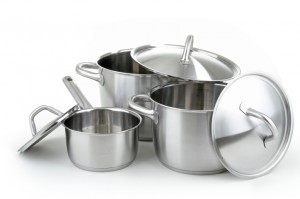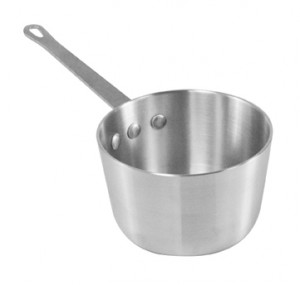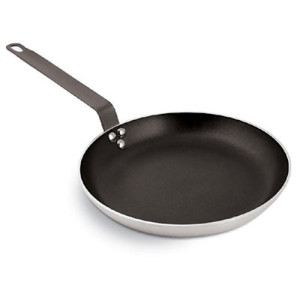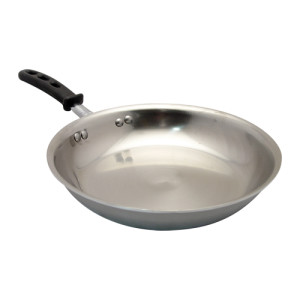 It goes without saying that commercial cookware is a must for any restaurant’s kitchen. These are the tools of the trade, and if you’re looking to buy professional cookware, chances are you already know exactly what you want and where to get it.
It goes without saying that commercial cookware is a must for any restaurant’s kitchen. These are the tools of the trade, and if you’re looking to buy professional cookware, chances are you already know exactly what you want and where to get it.
The purpose of this guide is not to give you a 101 on the types of cookware. I’m assuming you already know the basics. The purpose of this guide is to give you some information that may help you become a more discerning shopper when you need new cookware, not to tell you what a fry pan is and why you should use it over a sauce pan.
So based on the assumption you know the difference between sauce pans and fry pans, let’s move on to material. This is where your cookware buying decisions can start to get a little sticky. In general, there are three main factors to consider when deciding on the material you want in your cookware:
1. Price. Some materials are cheaper than others, plain and simple. In general the scale goes like this, from least expensive to most: aluminum, non-stick, stainless steel, and tri-ply. There are definitely some trade-offs between each type, which I’ll get into later in this post.
2. Durability. Heating, cooking, cooling, and cleaning all put serious stress on professional cookware. Some types of cookware are more durable than others, and durability is going to be a key factor to weigh against price when deciding what kind of cookware to buy.
3. Heat conduction. Since the purpose of cookware is to conduct heat to the ingredients you’re trying to cook, the efficiency with which different types of materials conduct heat is another important consideration.
You’re probably already familiar with the different types of materials professional cookware is made from. Let’s go through them anyway so we can weigh how each type stacks up against the three factors I outlined above.
Aluminum
Price: usually the lowest.
Durability: well, it depends on the kind of aluminum. 1100 series aluminum is the softest material available for professional cooking. It tends to warp and dent easily, which means it can have a short lifespan in a bustling commercial kitchen. 3000 series aluminum (including 3003 and 3004) is harder because an alloy has been added to the aluminum that makes it more durable. Of course, alloy aluminum is also going to be more expensive.
Heat conduction: just about the best. Technically, copper is a better conductor of heat than aluminum, but because copper reacts chemically to certain food types, and is even softer than aluminum, it typically isn’t used in commercial cookware. The exception to this is tri-ply cookware, which I’ll get into later.
Non-stick
Non-stick means the cookware has been coated with a special material that makes it harder for food to stick to the pan when cooking. This coating is usually applied to aluminum cookware and limited to types that are used for high heat applications – typically fry pans.
Price: a bit more than natural aluminum, but still very affordable compared to other materials.
Durability: it depends on how you care for it. Non-stick will scratch off very quickly if you use metal utensils during cooking or clean it with an abrasive surface like a brillo pad. And of course non-stick still has all the durability issues of other aluminum cookware.
Heat conduction: just as good as aluminum.
Stainless Steel
Price: more expensive than non-stick and natural aluminum.
Durability: stainless is about the most durable material you can get in commercial cookware.
Heat conduction: here’s where the trade-off with stainless steel comes in. On the one hand, you’ll get some super durable cookware. On the other, stainless steel doesn’t conduct heat very well at all compared to aluminum. Of course, it will get hot over time, and has pretty decent heat retention, but if you’re trying to get ingredients hot very quickly, stainless isn’t going to perform as well. That’s why stainless steel tends to perform best for long, slow, simmering type cooking, like stock pots and sauce pans.
Tri-Ply
Tri-ply is a hybrid of multiple materials, and in many ways this approach embodies the best attributes of stainless steel and aluminum.
Price: similar in price or more expensive than stainless steel.
Durability: tri-ply usually consists of a stainless steel body with a layer of copper or aluminum on the bottom to boost heat conduction. This gives your cookware the durability of stainless steel without sacrificing any heat transfer.
Heat conduction: is usually excellent because of the highly efficient conduction of the aluminum or copper layer on the bottom.
Finding the right trade-off between price and performance is the perennial problem of any equipment purchase. At least there are some intriguing options when it comes to professional cookware, and those options definitely give you some flexibility when it comes to deciding what kind of cookware you’d like in your kitchen.
 Corner Booth Blog | TundraFMP Restaurant Supply, News & Equipment Blog
Corner Booth Blog | TundraFMP Restaurant Supply, News & Equipment Blog







